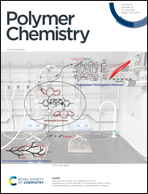A non-conjugated photothermal polymer complex absorbing light in visible and infrared windows†
Abstract
Solar energy is a renewable and natural alternative to fossil fuels. In order to efficiently use solar energy, photothermal conversion techniques and materials have been intensively investigated, which are gaining enormous interest in the area of energy conversion and storage. In solar light, 51% of the solar energy concentrates in the visible region and 43% in the infrared (IR) region. Broadening the absorption of photothermal materials is considered as an effective strategy to improve the light utilization efficiency. In this regard, many types of materials have been successfully exploited to achieve broad absorption both in visible and IR regions. However, few photothermal polymers are non-conjugated, as the conjugated polymers would have a low band gap for increasing non-irradiated emission to generate thermal energy. In this paper, we formulated an iodine doping process to endow a non-conjugated polymer complex with outstanding light-absorbing ability. This polymer solution was crosslinked with iodine into an organogel and well developed in the casting and coating areas. Several characterization techniques were carried out to explore the mechanism of the crosslinking process. The resulting polymeric non-conjugated photothermal materials showed pronounced photothermal conversion ability in both visible and IR regions and high stability up to 381 °C.



 Please wait while we load your content...
Please wait while we load your content...